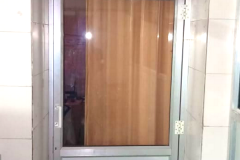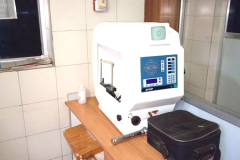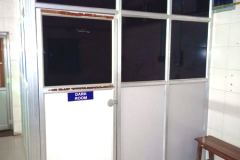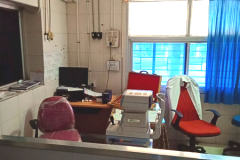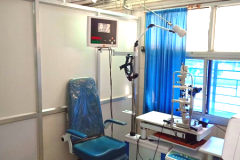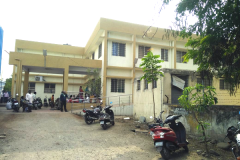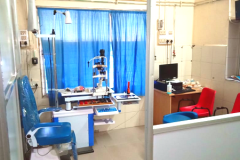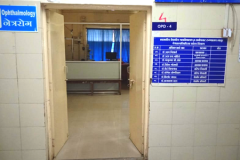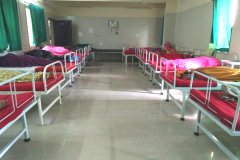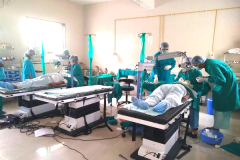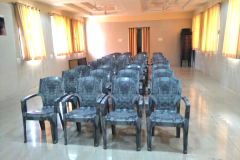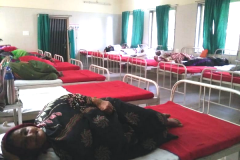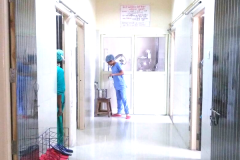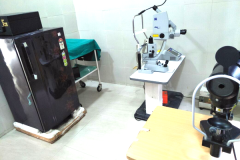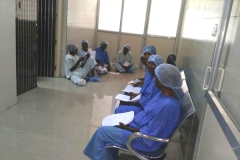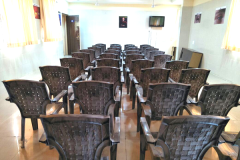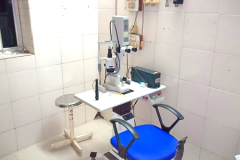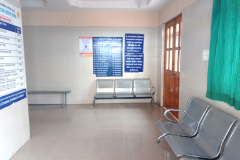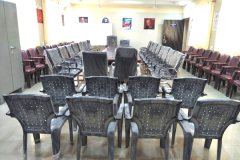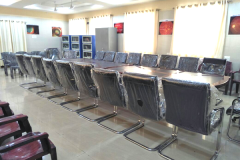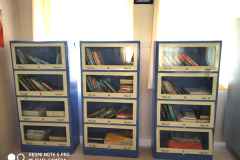The department of ophthalmology at GMC Latur provides a well equipped facility for the complete examination, diagnosis, and treatment (both medically and surgically) of all ocular diseases. The department is comprised of a dedicated and wellqualified team with excellent support from nursing and administrative staff. Eye disorders can be diagnosed and treated, including cataract, glaucoma, strabismus and amblyopia, ocular trauma, refractive disorders, cornea and external eye diseases, retinal disorders screening and treatment &lacrymal drainage disorders.
List of Departmental Faculty
|
DESIGNATIONS |
NUMBER |
NAMES |
| Professor & HOD | 01 | Dr. Mohite U.S |
| Associate Prof. | 01 | Dr. Dole N.B |
| Assistant Prof. | 01 | Dr. Gosavi V.S |
| Senior Resident /Tutor/Demons. | 03 | Dr. Kendre V. N
Dr.KishorJadhav Dr.GaradSatyakala
|
| Junior Resident | 08 | Dr. SayedAshfaq
Dr. KatareShailesh Dr. KolteDevesh Dr. Gandhi Niyati
Dr. GajreGaytri Dr. MeherMeenakshi Dr. AgarwalAayushi Dr. PatilSneha |
Facilities available
(i) Phaco Surgery – Available
(ii) Ophthalmic laser- Available (Nd-YAG Laser )
(iii) Eye Bank –Available
General Departmental facilities:
OPD
Large and spacious and airy
Consisting of
Cabins:05
Dark room:01
Refraction rooms:02
OPD procedure/Treatment room:01
Teaching space for undergraduates:01
WARDS
Number of wards:02
Huge, spacious, clean and well ventilated
Number of beds: 40
Separate wards for septic patients is also available
DEPARTMENT
Seminar hall: for various activities like PG activities, meetings of various departments
1 Conference hall
1 UG Seminar hall
Separate cabins for Professor and Associate Professors
OPERATION THEATRE
Well equipped with Air conditioner
consists of
No. of blocks 02
No. of tables 03
No. of microscopes-03
One separate septic OT
General anaesthesia facility also available.
The Department of Ophthalmology contributes to teaching a range of both undergraduate and postgraduate students.
Undergraduate Ophthalmology
150 students in the undergraduate medical curriculum are taught each year by
the Department of Ophthalmology with teaching occurring in 4th, and
6thsemister of the courses. In total each medical student spends two weeks
and 4 weeks being exposed to clinical and theoretical aspects of
ophthalmology, which are then used in many other subspecialty attachments.
Postgraduate Ophthalmology
The Department of Ophthalmology is heavily involved in the clinical training 4
residents each year who are pursuing M.S
PG teaching involves seminars, case presentations, journal clubs on weekly
basis
Department of Ophthalmology, GMC Latur( 3 YEAR DATA)
| Sr. No | Parameters | 2015 | 2016 | 2017 |
| 1 | Total number of patients in OPD | 23632 | 21723 | 17693 |
| 2 | Total number of patients admitted (IPD) | 1206 | 1447 | 1481 |
| 3 | Total Number of Major Operations | 913 | 1328 | 1062 |
| 4 | Total Number of Minor Operations | 249 | 185 | 150 |
List of papers- Department of Ophthalmology
Government Medical College , Latur
| Sr no | Topic | Journal | Authors |
|
1 |
Role of fluorescein angiography as an early intervention in detecting cystoid cystoid macular edema in post operative cataract surgery patients | International Journal of Recent Trends in Science And Technology, Volume 6, Issue 2, 2013 pp 77-78. |
Dr Dole NB Dr Mohite US |
|
2 |
Nucleus division with McPherson forcep in Small Incision Cataract Surgery.
|
Medpulse: International Medical Journal September 2014; 1(9): 544-547. |
Dr Dole NB Dr Mohite US |
|
3 |
Small incision cataract surgery with horizontal nucleus dividing forcep
|
Indian Journal of Basic and Applied Medical Research; June 2015: Vol.-4, Issue- 3, P. 313-319
|
Dr Dole NB Dr Mohite US |
Departmental Library:
- Total No. of Books.Total books- 105 ,journals-110,resident thesis-5
- Purchase of latest editions in last 3 years- 20
- of Journals –110
Equipments List
| Sr. No | Name of equipment | Quantity |
| 1 | Snellen’s Chart/Snellen drum with or without remote control | 4 |
| 2 | Trial set with trail frame both for adult and children | 4 |
| 3 | Perimeter | 1 |
| 4 | Colour vision chart | 4 |
| 5 | Near vision chart with different language | 4 |
| 6 | Cell torch | 12 |
| 7 | Ophthalmoscope (direct) | 4 |
| 8 | Streak Retinoscope | 4 |
| 9 | Slit lamp | 4 |
| 10 | Applanationtonometer | 3 |
| 11 | Keratometer | 2 |
| 12 | Indirect Ophthalmoscope | 1 |
| 13 | Maddox Rod | 1 |
| 14 | Synoptophore | 1 |
| 15 | Maddox Wing | 1 |
| 16 | Diplopia goggles | 1 |
| 17 | Gonioscope | 1 |
| 18 | Placido disc | 1 |
| 19 | Prism Bar | 1 |
| 20 | Schiotztonometer | 4 |
| 21 | Operating microscope with TV Unit with camera | 1 |
| 21 | Glaucome set | 3 |
| 22 | Cataract set | 6 |
| 23 | DCR set | 2 |
| 24 | Entropian set | 3 |
| 25 | Enucleation set | 5 |
| 26 | Evisceration set | 2 |
| 27 | Squint set | 3 |
| 28 | Operation Theatre Table | 2 |
| 29 | Operation Theatre Light | 2 |
| 30 | Slit lamp(ward) | 1 |
| 31 | Snellen’s chart with remote(ward) | 1 |
| 32 | Trial set with frame(ward) | 1 |
| 33 | Near vision chart (ward) | 1 |
| 34 | Torch(ward) | 2 |
| 35 | Direct Ophthalmoscope(ward) | 1 |
| 36 | Indirect ophthalmoscope(ward) | 1 |
| 37 | Autorefractometer(Preferably With Keratometer) | 2 |
| 38 | Goldmann’sApplanationTonometer | 4 |
| 39 | Nd:Yag Laser Machine With Abraham Lenses | 2 |
| 40 | 90d, 78d (Along With Slit Lamp) | 1 |
| 41 | Lensometer | 1 |
| 42 | Operating Microscope( For Minor Procedures In Opd) | 1 |
| 43 | Perkin’s Tonometer | 1 |
The Department of Ophthalmology contributes to teaching a range of both undergraduate and postgraduate students
Undergraduate Ophthalmology
150 students in the undergraduate medical curriculum are taught each year by
the Department of Ophthalmology with teaching occurring in 4th, and
6thsemister of the courses. In total each medical student spends two weeks
and 4 weeks being exposed to clinical and theoretical aspects of
ophthalmology, which are then used in many other subspecialty attachments.
Postgraduate Ophthalmology
The Department of Ophthalmology is heavily involved in the clinical training 4
residents each year who are pursuing M.S
PG teaching involves seminars, case presentations, journal clubs on weekly
basis
Future Plans
To develop into a Super speciality Eye Institute with Vitreo-Retinal, Pediatric-Ophthalmology, Squint , Glaucoma & Cornea sub-specialties.
Photo Gallery

